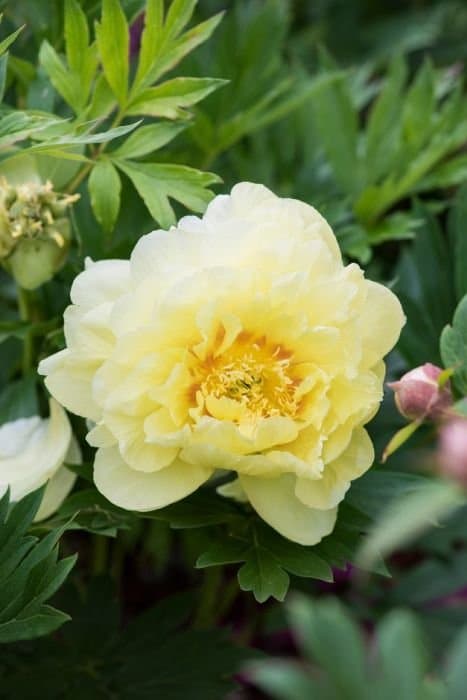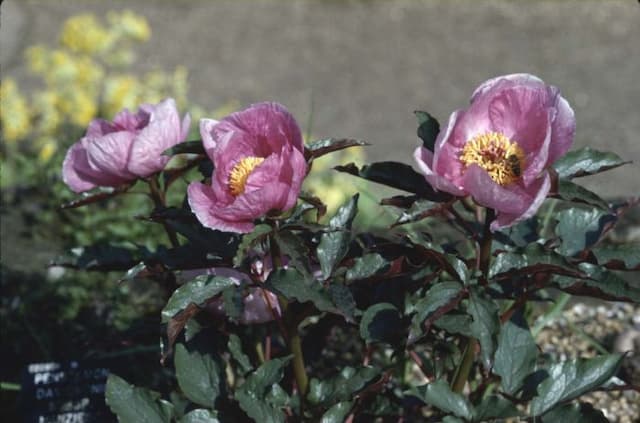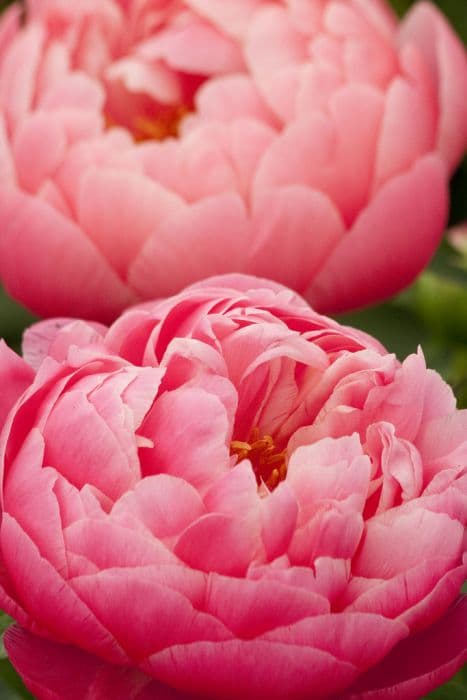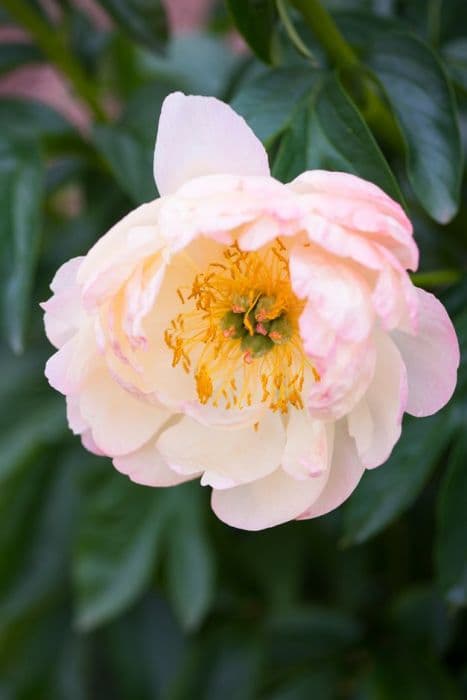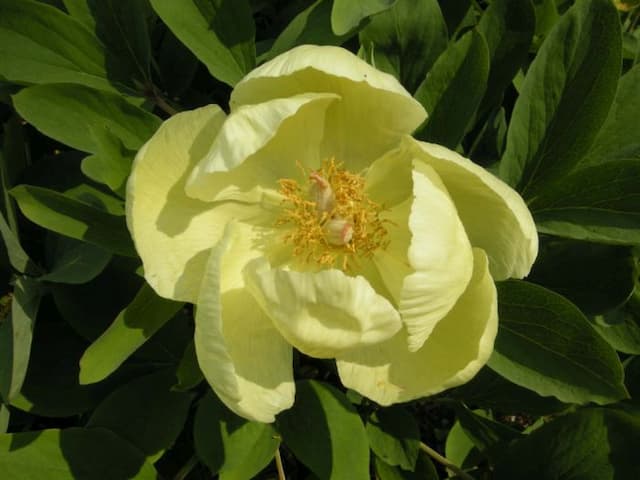Peony Paeonia 'Red Charm'
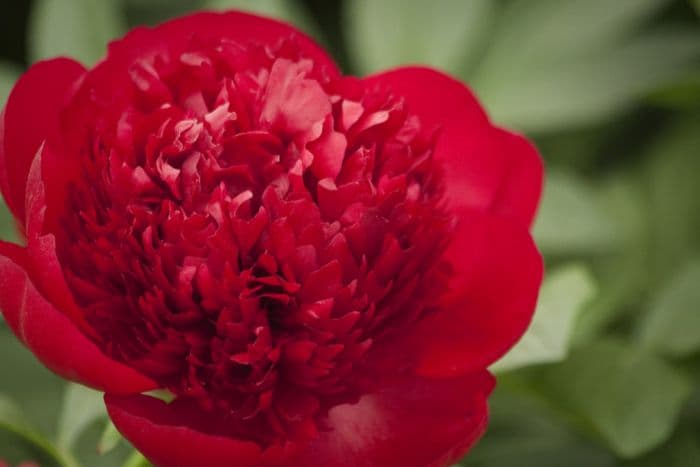
ABOUT
The Paeonia 'Red Charm' is a stunning perennial plant commonly known as a peony. It is particularly well-known for its large, sumptuous flowers that boast an incredible depth of color. The blossoms appear as large globes that open up to reveal layers of ruffled petals in a ravishing deep red hue, which sometimes appears almost burgundy, and may have a velvety texture. These flowers have a luxurious and full appearance, creating a striking visual impact when in bloom. At the center of the blooms, a group of small golden-yellow stamens adds a striking contrast to the dark red petals, creating a focal point that is both elegant and eye-catching. The flowers emit a delightful fragrance that is sweet and alluring, which makes this peony a favorite among gardeners and flower enthusiasts for both its beauty and scent. The foliage of the 'Red Charm' peony provides a lush backdrop for the flowers, with deep green, glossy leaves. These leaves are divided into leaflets that create an attractive form and texture within the plant as it stands in the garden. Even when not in bloom, the peony's foliage remains an attractive feature, emanating a sense of vigor and life. Overall, the 'Red Charm' peony's incredible flower form, rich coloration, and delightful fragrance, combined with its lush foliage, make it a showstopping addition to any garden space, and it is prized for its ornamental qualities throughout its blooming season.
About this plant
 Names
NamesFamily
Paeoniaceae
Synonyms
Red Charm Peony
Common names
Paeonia 'Red Charm'.
 Toxicity
ToxicityTo humans
Peony 'Red Charm' is not considered highly toxic to humans. However, consuming any part of the plant may cause mild gastrointestinal upset, including symptoms like nausea, vomiting, and diarrhea. It should not be ingested, and care should be taken to prevent children from consuming this plant. Skin contact with peony plants might also cause irritation in some individuals, so it is advisable to handle them with care.
To pets
Peony 'Red Charm' is considered toxic to pets, including dogs and cats. If ingested, it can cause gastrointestinal upset, which might manifest as vomiting or diarrhea. In some cases, it may also cause a rash or skin irritation if pets come into contact with the sap. It's important to keep peony plants out of reach of pets to prevent ingestion and potential poisoning.
 Characteristics
CharacteristicsLife cycle
Perennials
Foliage type
Deciduous
Color of leaves
Green
Flower color
Red
Height
2-3 feet (0.6-0.9 meters)
Spread
2-3 feet (0.6-0.9 meters)
Plant type
Herbaceous
Hardiness zones
3-8
Native area
Asia
Benefits
 General Benefits
General Benefits- Aesthetic Appeal: Paeonia 'Red Charm', also known as peony, produces large, vibrant red flowers that add a dramatic color and visual interest to gardens.
- Longevity: Peonies are known to live for many years, even decades, making them a long-lasting addition to any landscape.
- Hardiness: Red Charm peonies are hardy plants that can survive harsh winters, with many varieties tolerant of cold climates.
- Perennial Growth: Peonies return each year with minimal care, reducing the need for annual planting and seasonal garden design updates.
- Attracts Pollinators: The blooms of the peony attract bees and other pollinators, supporting the health of the garden ecosystem.
- Cut Flower Potential: Peonies make excellent cut flowers for bouquets and arrangements, with a single plant providing numerous blossoms during the season.
- Garden Structure: Peonies can help define the structure and borders within a garden design due to their size and form.
- Versatility: These plants can be used in a variety of garden styles, including borders, cottage gardens, and as focal points in landscape designs.
 Medical Properties
Medical PropertiesThis plant is not used for medical purposes.
 Air-purifying Qualities
Air-purifying QualitiesThis plant is not specifically known for air purifying qualities.
 Other Uses
Other Uses- Floral Artwork - Paeonia 'Red Charm' blooms can be dried and pressed to create beautiful floral artwork pieces.
- Photography Subject - Its striking red flowers make it an excellent subject for photographers, especially for macro photography.
- Culinary Garnish - The petals of Paeonia 'Red Charm' can be used to garnish desserts and salads for an elegant touch.
- Wedding Decor - Due to their large, vibrant blooms, these flowers are often used in wedding bouquets and centerpieces.
- Fragrance Inspiration - The flower's scent can inspire perfumers to create unique floral fragrances.
- Natural Fabric Dye - The petals can be used to create a natural dye for fabrics, yielding unique shades of red and pink.
- Bookmark Decoration - Pressed peony petals can be laminated to create delicate bookmarks.
- Ice Cube Embellishment - Freeze peony petals in ice cubes to add a splash of color and sophistication to beverages.
- Potpourri Ingredient - Dried peony petals contribute to visually appealing and fragrant potpourri mixes.
- Cultural Symbolism - In particular cultures, Paeonia 'Red Charm' may be used in celebrations or as a symbol of prosperity and honor.
Interesting Facts
 Feng Shui
Feng ShuiThe Peony is used in Feng Shui to promote romance and prosperity. The 'Red Charm' variety, with its rich red flowers, can be placed in the southwest corner of a garden or home to enhance love and marriage luck.
 Zodiac Sign Compitability
Zodiac Sign CompitabilityThe Peony is not used in astrology practice.
 Plant Symbolism
Plant Symbolism- Romance and Love: Due to its vibrant red color, the Peony 'Red Charm' is often associated with deep love and romance, embodying passion and the timeless allure of a classic love story.
- Prosperity and Good Fortune: Peonies in general are seen as symbols of wealth and good fortune, making the 'Red Charm' variety a popular choice for celebrations seeking to invite abundance.
- Honor and Respect: With its regal appearance, the Peony 'Red Charm' can also symbolize honor and respect, often used to convey admiration for someone's integrity and achievements.
- Feminine Beauty: The full, lush blooms of the Peony 'Red Charm' are frequently associated with the ideal of feminine beauty and grace.
- Compassion and Bashfulness: Peonies may also represent compassion, as well as the bashfulness of someone who blushes easily, tying in to the delicate nature of the blooms.
- Happy Marriage: In certain cultures, Peony 'Red Charm' is believed to be a good omen for a happy marriage, offering blessings for a union filled with joy and mutual respect.
- Healing: Historically, peonies including the 'Red Charm' variety, have been used for their medicinal properties, symbolizing the healing of physical and emotional ailments.
 Water
WaterPeonies like 'Red Charm' should be watered deeply once a week during a dry spell, ensuring that the soil around them becomes thoroughly moistened, which generally means applying about an inch of water. Watering should be done at the base of the plant to avoid wetting the foliage, as this can increase the risk of fungal diseases. During the growing season, it's ideal to water them in the morning so the leaves have time to dry out during the day. When the plant is dormant in winter, reduce watering significantly, but do not allow the roots to dry out completely.
 Light
LightPeonies, including the 'Red Charm' variety, thrive in full sun to partial shade. They need a minimum of six hours of sunlight to bloom well. Ideally, they should be planted in a spot where they receive morning sunlight and some afternoon shade, especially in hotter climates, to protect them from the intense late-day rays.
 Temperature
Temperature'Red Charm' peonies are hardy and tolerate a wide range of temperatures, but they grow best when the daytime temperature is between 65°F and 75°F and the nighttime temperature does not drop below 40°F. They can survive winter cold down to -30°F, which allows for a period of winter dormancy that is necessary for bud formation. However, prolonged exposure to temperatures above 85°F in summer may reduce blooming and overall vigor.
 Pruning
Pruning'Red Charm' peonies should be pruned to remove spent flowers after blooming to maintain a tidy appearance and encourage more blooms for the following year. Pruning should also be done in the fall after the leaves have died back, cutting the stems to about 3 inches above the ground level. This helps reduce disease pressure and prepares the plant for winter.
 Cleaning
CleaningAs needed
 Soil
SoilThe best soil mix for Peony 'Red Charm' is well-draining, fertile soil with abundant organic matter. A pH between 6.0 to 7.0 is ideal for this plant to thrive. Incorporating compost or well-rotted manure into the soil can greatly enhance its structure and nutrient content.
 Repotting
RepottingPeonies like 'Red Charm' rarely need to be repotted as they are typically grown outdoors and establish deep root systems. If planted in containers, repotting can be done every few years as the plant outgrows its pot, ideally in the fall after flowering.
 Humidity & Misting
Humidity & MistingPeony 'Red Charm' does well in average garden humidity levels and does not require specific humidity conditions. It is important to ensure good air circulation around the plant to prevent any humidity-related fungal diseases.
 Suitable locations
Suitable locationsIndoor
Peonies like 'Red Charm' generally do not grow well indoors due to their sunlight needs.
Outdoor
Plant in full sun, well-drained soil, and space adequately for air flow.
Hardiness zone
3-8 USDA
 Life cycle
Life cycleThe life cycle of the Peony 'Red Charm' begins with seed germination, where the seed requires well-drained soil and a period of stratification (cold treatment) to break dormancy. Following germination, the seedling stage is characterized by the emergence of initial leaves and roots as the plant establishes itself. As the peony matures into the vegetative stage, it develops a strong root system and foliage, with leaves growing larger and stems becoming more robust. The peony enters the flowering stage in late spring to early summer, producing large, showy red flowers that are highly sought after for their beauty and fragrance. After pollination, which is often facilitated by insects, the plant may produce seeds, completing the reproductive cycle. Finally, peonies enter a period of dormancy in late autumn or early winter as the foliage dies back, and they store energy in their roots for the next growing season.
 Propogation
PropogationPropogation time
Late winter-early spring
The Paeonia 'Red Charm', commonly known as the Red Charm peony, is typically propagated through root division. The best time to propagate peonies by dividing is in the fall, when the plants have died back and are dormant. To do this, you would dig up an established peony plant, gently shake off the soil, and locate the tuberous roots. Using a sharp knife or garden tool, cut the roots into sections, ensuring that each division has at least 3-5 eyes, which are the growth points for new shoots. Afterward, the divisions should be planted in well-drained soil at a depth where the eyes are approximately 1.5-2 inches (3.8-5.1 cm) below the surface of the soil. Water well after planting to help establish the new plants.
